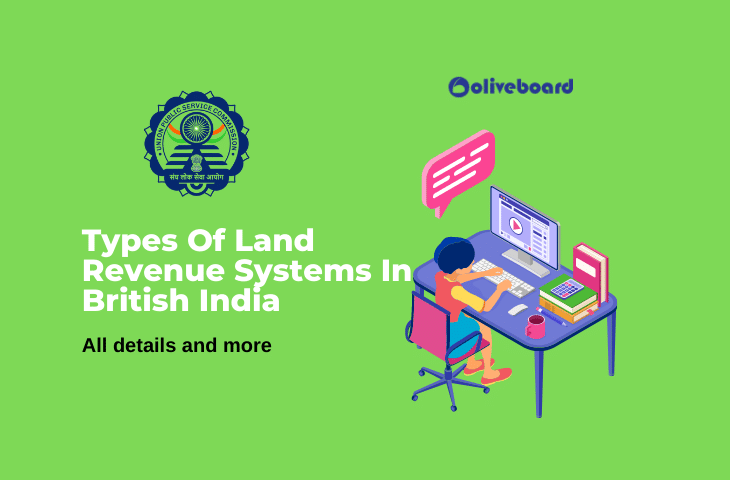Indian cottage and agriculture industries were inextricably linked until the 18th century. India occupied a prominent position in the world’s handicraft and agriculture production. By establishing revolutionary land tenure structures and revenue administration practices, British colonial rulers devastated the handicraft sector while also generating far-reaching changes in the country’s agrarian structure.
- Permanent Settlement/ Zamindari System: Bihar, Bengal, Banars, and the NWFP divisions accounted for roughly 19% of the total area under British rule.
- Ryotwari System: Assam, Bombay, and Madras Presidencies covered approximately 51% of the area under British rule.
- Mahalwari System: Covered 30% of the area under British rule, including major parts of the NWFP, central provinces, and Punjab.
There were different types of land revenue systems in British India, namely,
- Zamindari
- Ryotwari
- Mahal Wari
Land Revenue Systems Prior To British Rule
From ancient times, land taxation was a major source of revenue for kings and emperors. However, the land ownership pattern has changed over the centuries. The land was divided into Jagirs during Kingship, and Jagirs were allotted to Jagirdars, who divided the land and assigned it to subordinate Zamindars. Zamindars forced peasants to cultivate the land and collected a portion of their revenue as tax.
British India’s Land Revenue Systems
Under British rule, there is a land revenue system. In 1765, the British obtained Diwani rights over Bengal, Bihar, and Orissa. The British East India Company’s main goal was to increase its land revenue collection. As a result, its policies aimed to maximise income from land while disregarding the consequences for cultivators and peasants. In India, there were three major systems for collecting land revenue.
Zamindari System (Permanent Land Revenue Settlement)
- Cornwallis introduced the Zamindari System in 1793 through the Permanent Settlement Act, and they implemented it in the provinces of Bengal, Bihar, Orissa, and Varanasi.
- It is also known as the Permanent Settlement System.
- Zamindars were recognised as the landowners. Zamindars were given the authority to collect rent from peasants.
- While the zamindars became landowners, they made the actual farmers tenants.
- The tax was to be paid even if the yield was low, and it was to be paid in cash. Before implementing this system, they could pay the tax in kind.
- The total amount realised would be divided into 11 parts. Zamindars own one-tenth of the Company, while East India Company owns ten-tenths of the Company.
Ryotwari System
- In 1820, Thomas Munro developed the Ryotwari System, which was South India’s major land revenue system.
- Bombay, Madras, and parts of British India’s Coorg and Assam provinces were major areas of introduction.
- Under the Ryotwari System, peasants were given ownership rights. The British Government collected taxes from peasants directly.
- The Ryotwari System generated 50% of its revenue on dry land and 60% on irrigated land.
- Even though farmers owned the land, the British Government impoverished them due to excessive taxation. Furthermore, they raised tax rates regularly.
Mahalwari System
- Holt Mackenzie introduced the Mahalwari system in 1822. Later, during the reign of William Bentick, they reformed the system (1833).
- This was the major land revenue system in North-West India.
- It was introduced in British India’s Central Province, Agra, Gangetic Valley, Punjab, North-west Frontier and a few more areas.
- The land was divided into Mahals underneath this system. Each Mahal consists of one or more villages.
- The entire village (Mahal) was treated as a single unit for tax purposes.
- The village headman or village committee collected taxes, and peasants retained ownership rights.
- The tax rate was also excessive in this system.
- The Mahalwari system incorporated many features from both the Zamindari and Ryotwari systems.
Conclusion
We hope the article has provided you with the relevant details on types of land revenue systems in British India. For any queries, contact us at Oliveboard.
FREQUENTLY ASKED QUESTIONS
Charles Reed and Munro
Thomas Munro and Charles Reed introduced the Ryotwari System to India in 1820. It was first used during the Madras presidency. The British Government collected taxes directly from peasants at this time.
(a) The rajas and taluqdars were elevated to the status of zamindars.
(b) They were in charge of collecting revenue from peasants and remitting it to the Company.
(c)The revenue demand was set in stone.
In 1822, Holt Mackenzie established the Mahal Wari system. The other two systems were the Permanent Settlement in Bengal, which was established in 1793, and the Ryotwari system, which was established in 1820. It included parts of the states of Punjab, Awadh, and Agra, as well as parts of Orissa and Madhya Pradesh.
Under the Mahal Wari system, the village headmen collected land revenue from farmers on behalf of the entire village. Land revenue was paid directly to the state by farmers under the Ryotwari system. The Imperialist East India Company established the Zamindari system in 1793.
The peasants or cultivators were considered the landowners under this system. They had ownership rights to the land and could sell, mortgage, or gift it. The Government collected taxes directly from the peasants. Sir Thomas Munro, Governor of Madras in 1820, established this system of land revenue in the late 18th century. This was done in the Madras and Bombay areas, as well as the provinces of Assam and Coorg.
- UPSC Calendar 2026 PDF Out, Check All Exam Dates & Notifications
- UPSC EPFO Salary 2025, Pay Scale, Job Profile, Check Here
- UPSC Form Filling Format 2025, Get Latest Form Format in Detail
- What if I fail UPSC Prelims, How to Tackle UPSC Failure
- 10 Alternatives for UPSC Aspirants, Check 10 Best Alternatives
Hi, I’m Tripti, a senior content writer at Oliveboard, where I manage blog content along with community engagement across platforms like Telegram and WhatsApp. With 3 years of experience in content and SEO optimization, I have led content for popular exams like SSC, Banking, Railways, and State Exams.
